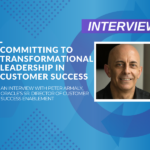In today’s marketplace, understanding and meeting customer expectations isn’t just important – it’s paramount. Crafting a customer lifecycle that aligns with the experience your customer wants and expects is critical to driving value and adoption across your entire customer base. While the core lifecycle should remain consistent for all customers – ensuring scalable and efficient success in driving outcome achievement, product adoption, measurable value realization, renewal, expansion and advocacy- the way each customer segment or persona experiences this lifecycle needs careful consideration. A one-experience-for-all approach simply isn’t enough. Forward thinking organizations are democratizing their customer lifecycle and leveraging omni-channel to scale and personalize customer engagement effectively.
Omni-Channel approaches to the Acquisition phase of the customer lifecycle have become table stakes for Sales and Marketing. However, in recurring revenue business models, extending this omni-channel approach through to Adoption, Retention and Expansion ensures a seamless experience across the entire customer lifecyle. An omni-channel strategy creates a consistent and personalized experience across all touch points, enabling businesses to scale customer interactions while offering customers multiple ways to engage with your organization – even on their own terms.
At Valuize, we have identified 9 key best practices for deploying an omni-channel customer lifecycle:
1. Cross-Channel Integration
A unified data platform, data lake or BI system is key to integrating data across all channels. This integration ensures that, no matter where a customer interacts with your brand, data is tracked and organized across all systems. It allows sales, marketing, customer success and product to share insights and make informed decisions or rules about communications, scoring and measurement, ensuring a consistent experience for every customer.
Messaging consistency is also critical. While the tone, style, and key messages should be uniform, they must be tailored to fit each channel’s format. Establish rules to ensure that communications align with the customer journey, avoiding over-communication or mixed messages.
2. Automation and Personalization
Use automation tools, like your Customer Success Platform (CSP), Marketing Automation Platform (MAP), or Sales/CS Enablement platforms to deliver personalized content at the right time through the right channel. Automate emails, follow-ups, and lead nurturing sequences based on user behavior and stage in the journey. Utilize AI to predict customer behavior and deliver personalized experiences, such as recommending content or products based on past interactions.
3. Cross-Channel Analytics
Analytics tools are essential for monitoring customer interactions across channels. This includes tracking email opens, social media engagement, website visits, and support/knowledge based interactions. Your analytics should also be configured to account for the customer journey stage and the critical milestones at each stage. Define key performance indicators (KPIs) for each stage and channel, and review these metrics regularly to identify bottlenecks and opportunities for improvement.
4. Seamless Customer Enablement
Ensure consistency in reactive customer support and proactive enablement across all channels, whether through named or pooled resources and in-app messaging. Use your system-of-record to track all customer interactions so that customer-facing resources have all the necessary information at hand, and integrate these interactions with your unified data platform. Offer self-service options such as a knowledge base or AI-powered chatbots to quickly resolve common issues, and configure in-app prompts and messaging to drive adoption and enablement.
5. Feedback Loops
Tailor surveys, NPS scores, and direct feedback to gauge customer satisfaction at various stages of the journey. Use telemetry data, customer engagement with communications and web properties to understand how customers are interacting with your business at each stage of the process. Act on this feedback to continuously improve the experience. Regularly test different approaches and messages across channels to determine what works best, using these insights to refine your customer journey strategy.
6. Cross-Functional Collaboration
Alignment across teams is vital. Ensure that sales, marketing, customer success, and support teams are aligned in their goals, engagement strategies and a unified vision for the customer experience. Regular communication and collaboration are key to delivering a seamless customer journey. Establish shared goals with clear accountabilities across teams to ensure that everyone is working towards the same objectives to deliver a consistent experience.
7. Digital Customer Journey Orchestration
Use real-time digital journey orchestration tools, like your Customer Success Platform or Marketing Automation Platform to adjust the customer’s path based on their latest interactions. Ensure these tools are integrated to maintain alignment in messaging and cadence, keeping the journey relevant and personalized as customer needs evolve.
Plan for different scenarios that might occur during the journey (e.g., what happens if a customer doesn’t respond to an email) and predetermine actions to maintain a smooth journey..
8. Content Strategy
Create an aligned content strategy across Sales, Marketing, Product and Customer Success, ensuring an agreed approach to customer engagement at each stage of the journey. Create relevant, engaging content tailored to each stage and channel helping customers move seamlessly to the next stage. Strategically distribute content across channels to reach the customer at the right time and place.
9. Continuous Optimization
As with any strategy, regularly review and refine the customer journey based on performance data and feedback. Adjust strategies, tools, and messaging as needed, staying agile and ready to adapt quickly to changes in customer behavior or market conditions. By implementing these methods, you can create a cohesive, personalized multi-channel customer journey that effectively guides customers towards your desired outcomes.
In today’s competitive landscape, delivering a seamless, omni-channel customer lifecycle is no longer optional—it’s a necessity. By integrating data across channels, leveraging automation and personalization, and fostering cross-functional collaboration, you can create a customer experience that not only meets but exceeds expectations. Continuous optimization, driven by data and customer feedback, ensures that your strategy remains agile and relevant as market conditions evolve. At Valuize, we believe that a well designed and operationalized customer lifecycle is the key to driving customer adoption, retention and expansion. By implementing these best practices, your organization can unlock the full potential of your customer relationships, turning every touchpoint into an opportunity for growth.






